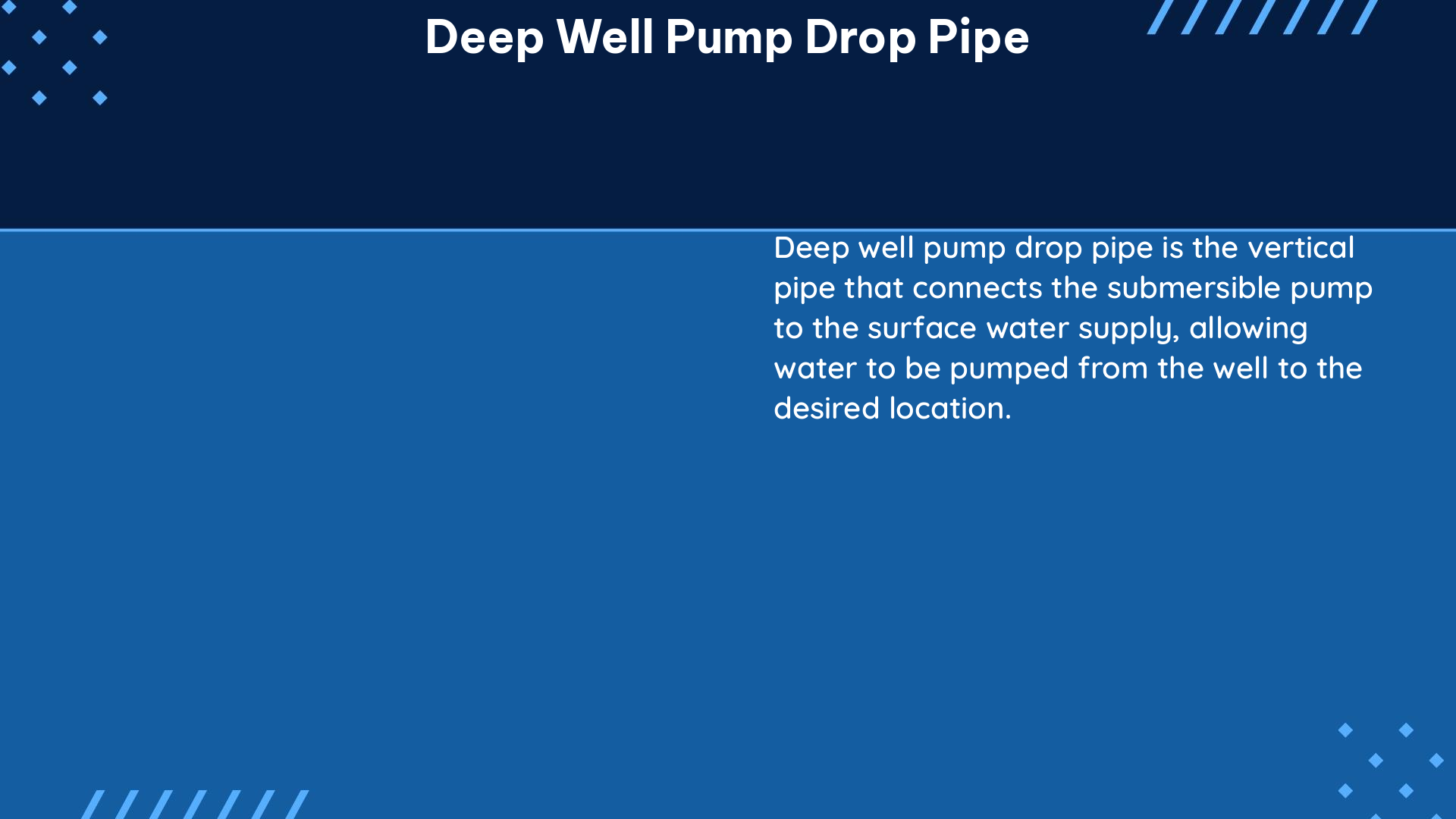Deep well pump drop pipes are crucial components in the efficient operation of submersible pumps in wells. The selection of the appropriate drop pipe size and material is essential for the system’s overall performance, longevity, and safety. This comprehensive guide will delve into the technical details and quantifiable data points related to deep well pump drop pipes, providing a valuable resource for DIY enthusiasts and professionals alike.
Pipe Size (Inside Diameter)
The inside diameter (ID) of the drop pipe significantly impacts the flow rate and friction loss. A larger ID allows for higher flow rates with reduced friction, while a smaller ID can result in increased friction and reduced flow. Consider the following examples:
- 1 ¼” PVC Schedule 40 pipe has an ID of 1.38″
- 1 ½” PE 4710 SR11 pipe has an ID of 1.53″
- 2″ PVC Schedule 40 pipe has an ID of 2.067″
The choice of pipe size should be based on the system’s flow rate requirements and the desired balance between friction loss and pump efficiency.
Flow Rate

The flow rate is the volume of water that the system can pump per minute, measured in gallons per minute (GPM). This parameter is crucial in determining the friction loss and total dynamic head (TDH) requirements. For instance, a system with a flow rate of 6.6 GPM will have specific friction loss and TDH needs, which may differ from a system with a flow rate of 10 GPM.
Pipe Length
The length of the drop pipe and the pipeline from the pump to the storage tank affects the friction loss and TDH. Longer pipe runs will result in higher friction losses, requiring the pump to work harder to overcome the resistance. Consider the following example:
- Column pipe in the well: 260 ft
- Pipeline from well to storage tank: 10 ft
- Total pipe length: 270 ft
Accurately measuring the pipe length is essential for calculating the system’s friction loss and TDH.
Pipe Roughness
The roughness of the pipe’s interior surface can influence friction loss. Pipes with a smoother interior, such as plastic (PVC, PE) or stainless steel, typically have lower friction loss compared to rougher surfaces, like galvanized steel. The Hazen-Williams roughness coefficient (C-factor) is a common measure of pipe roughness, with higher values indicating a smoother surface:
- PVC: C-factor of 150
- PE: C-factor of 150
- Galvanized steel: C-factor of 120
Selecting a pipe material with a higher C-factor can help reduce friction losses in the system.
Friction Loss
Friction loss is the loss of pressure due to the resistance of water flowing through the pipe. It is calculated using the pipe’s ID, flow rate, length, and roughness. Accurate friction loss calculations are crucial for determining the TDH and selecting the appropriate pump. The Darcy-Weisbach equation is commonly used to calculate friction loss:
hf = (f * L * V^2) / (2.31 * D)
Where:
hf = Friction loss (ft)
f = Friction factor
L = Pipe length (ft)
V = Velocity (ft/s)
D = Pipe diameter (ft)
Consulting friction loss tables or using online calculators can simplify the process of determining the friction loss for a given system.
Total Dynamic Head (TDH)
TDH is the total height that a pump must lift water, including vertical lift, elevation head, and friction losses. Accurate TDH calculations are essential for selecting the right pump and ensuring the system’s efficiency. For example, a system with a flow rate of 6.6 GPM may have a TDH of 270 ft, which the pump must be able to overcome.
Maximum Allowable Pump Setting Depth
The maximum allowable pump setting depth depends on the pipe’s size, schedule, and manufacturer’s recommendations. For schedules 80 and 120 PVC drop pipes, the maximum allowable pump setting depth is typically specified by the manufacturer. Exceeding this depth can lead to pipe failure and potential system damage.
Maximum Horsepower Allowable
The maximum horsepower allowable for a drop pipe also depends on the pipe’s size, schedule, and manufacturer’s recommendations. Selecting a pump with a horsepower rating that exceeds the pipe’s maximum allowable value can result in pipe failure and safety hazards.
Tensile Strength
Tensile strength is the maximum amount of stress that a material can withstand while being stretched or pulled before breaking. This parameter is crucial for ensuring the pipe’s structural integrity, especially in deep well applications where the pipe must support the weight of the pump and the water column. For example, the tensile strength of schedule 40 steel pipe is 8,173 pounds, taking into account the wall loss due to threading.
By understanding these technical details and quantifiable data points, you can make informed decisions when selecting and installing a deep well pump drop pipe, ensuring the system’s optimal performance, longevity, and safety.
Reference:
- Deep Well Drop Pipe Size
- Solar-Powered Water Pump Systems for Stockwater Design
- Tech Topics: Revisiting Drop Pipe Load-Bearing Capacity

The lambdageeks.com Core SME Team is a group of experienced subject matter experts from diverse scientific and technical fields including Physics, Chemistry, Technology,Electronics & Electrical Engineering, Automotive, Mechanical Engineering. Our team collaborates to create high-quality, well-researched articles on a wide range of science and technology topics for the lambdageeks.com website.
All Our Senior SME are having more than 7 Years of experience in the respective fields . They are either Working Industry Professionals or assocaited With different Universities. Refer Our Authors Page to get to know About our Core SMEs.